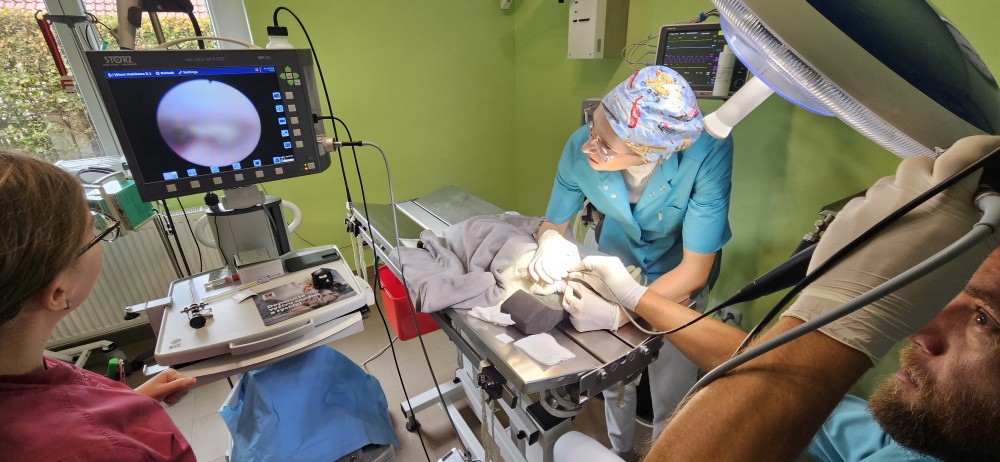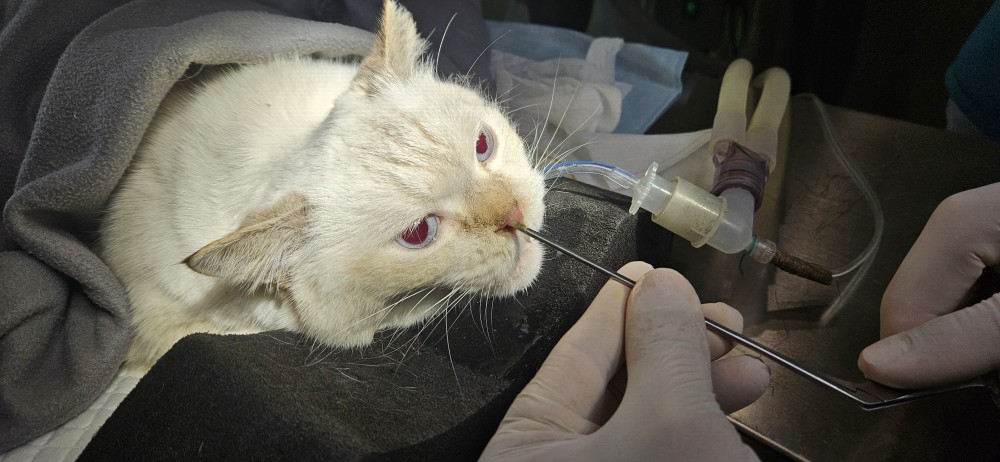Rhinoscopy
Rhinoscopy is an examination of the nasal passages using two special cameras: a rigid camera for insertion into the nasal passages and a flexible endoscopic camera for examination of the back of the nose and oral cavity. Rhinoscopy is important in diagnosing patients with fungal nasal disease, foreign bodies, nasal cancer or chronic rhinitis.

What is rhinoscopy?
A nasal endoscopy or rhinoscopy is a procedure in which the inside of an animal's nasal cavities are examined. The veterinarian inserts an endoscope (a long tube with a camera and light) into the back of the nose through the muzzle and also directly into the nasal cavity. The camera takes video footage and projects it onto a screen.
In which cases do we recommend rhinoscopy?
Rhinoscopy is an examination of the nasal passages and nasopharynx using an endoscopic camera. The purpose of the examination is to reveal the causes of nosebleeds, chronic rhinitis, difficulty breathing, nasal passage disorders (inflammation, polyp, tumor) or sinusitis. It is also used to remove foreign objects such as grass, seeds or even insects.
How do we perform a rhinoscopy on an animal?
- Rhinoscopy is always performed under anaesthesia. This is so that the animal remains calm and its lungs are protected from the fluid that is used to rinse the nose during the procedure.
- Once anaesthetised, the animal is positioned so that its head is still while the doctor examines the inside of its nose using a soft, flexible endoscopic camera.
- Images are taken and any abnormal areas are identified, which often contain many foreign bodies.
- Then the doctor switches to a fixed camera that is inserted into the nostrils. He examines the inside of the pet's nose and takes biopsies of nasal tissue for histopathological examination (examining cell types) and culture (growing bacteria or fungi).
- While the fixed camera is in the animal's nose, a lavage with warm saline is performed to help remove the discharge. Animals with blocked noses often feel significantly better after the procedure.

Is rhinoscopy painful?
Rhinoscopy should not hurt, although sometimes bleeding from the biopsy sites can occur and animals may sneeze a little more. These symptoms usually resolve on their own within one or two days.
How long does a rhinoscopic examination take?
In most cases, the rhinoscopy takes approximately 30-45 minutes.
What are the risks of rhinoscopy?
In general, rhinoscopy is very safe. Exceptionally, adverse reactions related to anaesthesia may occur (if the patient has other airway-related problems) or if the disease has spread from the nose to the brain.
When will you receive the results of the rhinoscopy examination?
Your veterinarian will discuss the results with you on the day of the examination.
How long does a pet have to stay in the veterinary clinic after a rhinoscopy?
For animals that are otherwise fine, rhinoscopy is usually a one-day procedure and the animal can go home the same day.
15.09.2025

